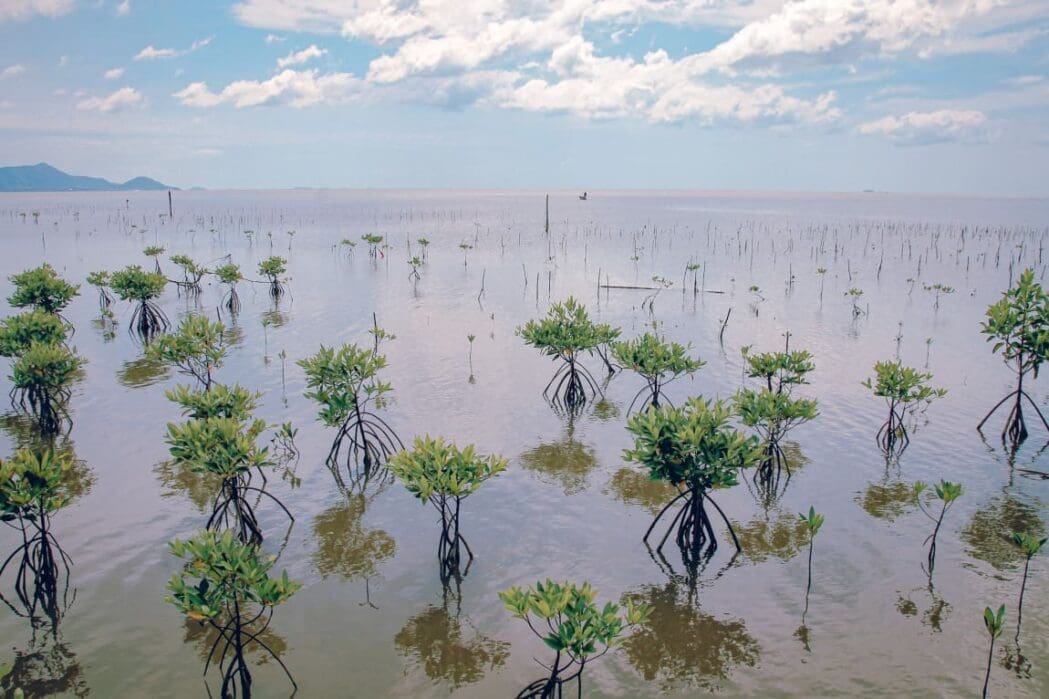In a report released today, the International Union for Conservation of Nature (IUCN) warns that more than half of the world’s mangrove ecosystems are at risk of collapse by 2050. This alarming findings comes from the first global mangrove assessment conducted for the IUCN Red List of Ecosystems, unveiled on the International Day for Biodiversity.
The assessment reveals that 50% of the mangrove ecosystems evaluated are classified as Vulnerable, Endangered, or Critically Endangered. Nearly 20% (19.6%) of these ecosystems face the highest risk, categorized as either Endangered or Critically Endangered, indicating severe threats to their survival.
Mangroves, essential for coastal protection, carbon storage, and supporting fisheries, are increasingly threatened by human activities such as deforestation, development, pollution, and dam construction. However, climate change poses a growing risk, with one-third (33%) of the assessed mangrove ecosystems threatened by sea-level rise and the increasing frequency of severe storms.
“IUCN’s Red List of Ecosystems is key to tracking progress towards the goal of halting and reversing biodiversity loss, in line with the Kunming-Montreal Global Biodiversity Framework,” said Dr. Grethel Aguilar, IUCN Director General. “The first global assessment of mangrove ecosystems gives key guidance that highlights the urgent need for coordinated conservation of mangroves – crucial habitats for millions in vulnerable communities worldwide.”
The study categorized the world’s mangrove ecosystems into 36 regions, assessing the threats and risks of collapse in each area. Over 250 experts from 44 countries contributed to this assessment, involving institutions like the IUCN Commission on Ecosystem Management, IUCN Species Survival Commission, and Global Mangrove Alliance.
Angela Andrade, Chair of IUCN Commission on Ecosystem Management, emphasized the importance of mangroves: “Mangrove ecosystems are exceptional in their ability to provide essential services to people, including coastal disaster risk reduction, carbon storage and sequestration, and support for fisheries. Their loss stands to be disastrous for nature and people across the globe. That is why this assessment is so important.”

Without significant changes by 2050, the assessment warns of substantial losses due to climate change and sea-level rise, including:
- 1.8 billion tonnes of carbon stored (17% of the total current carbon stored in mangroves), valued at a minimum of $13 billion in voluntary carbon markets, with a societal cost of $336 billion.
- Protection for 2.1 million lives currently shielded from coastal flooding, amounting to $36 billion in property protection.
- 17 million days of fishing effort annually (14% of current fishing effort is supported by mangroves).
The report highlights that maintaining mangrove ecosystems is crucial for mitigating climate change impacts. Healthy mangroves can better withstand sea-level rise and provide inland protection from hurricanes, typhoons, and cyclones.
The Red List of Ecosystems is a vital tool in combating global biodiversity loss, offering clear pathways for reversing mangrove loss and protecting these critical ecosystems. The assessment will also support global commitments like the Mangrove Breakthrough, which aims to secure the future of 150,000 km² of mangroves.
By preserving existing mangrove forests and restoring lost areas, stakeholders can increase resilience against climate change. Maintaining sediment flows and allowing space for mangroves to expand inland are key strategies for helping these ecosystems adapt to sea-level rise. The detailed findings of the Red List of Ecosystems assessment provide invaluable guidance for regional and national conservation efforts.
Established in 2014, the Red List of Ecosystems is a global standard for evaluating the conservation status of environments, helping to assess and monitor ecosystem health and threats. It complements other IUCN tools like the Red List of Threatened Species and the World Database on Protected Areas, reinforcing the global efforts to protect biodiversity.
Featured image: Closeup shot of Mangrove tree saplings planted in the forest of Trapeang Sangkae in Kampot, Cambodia. Credit: wirestock | Freepik




